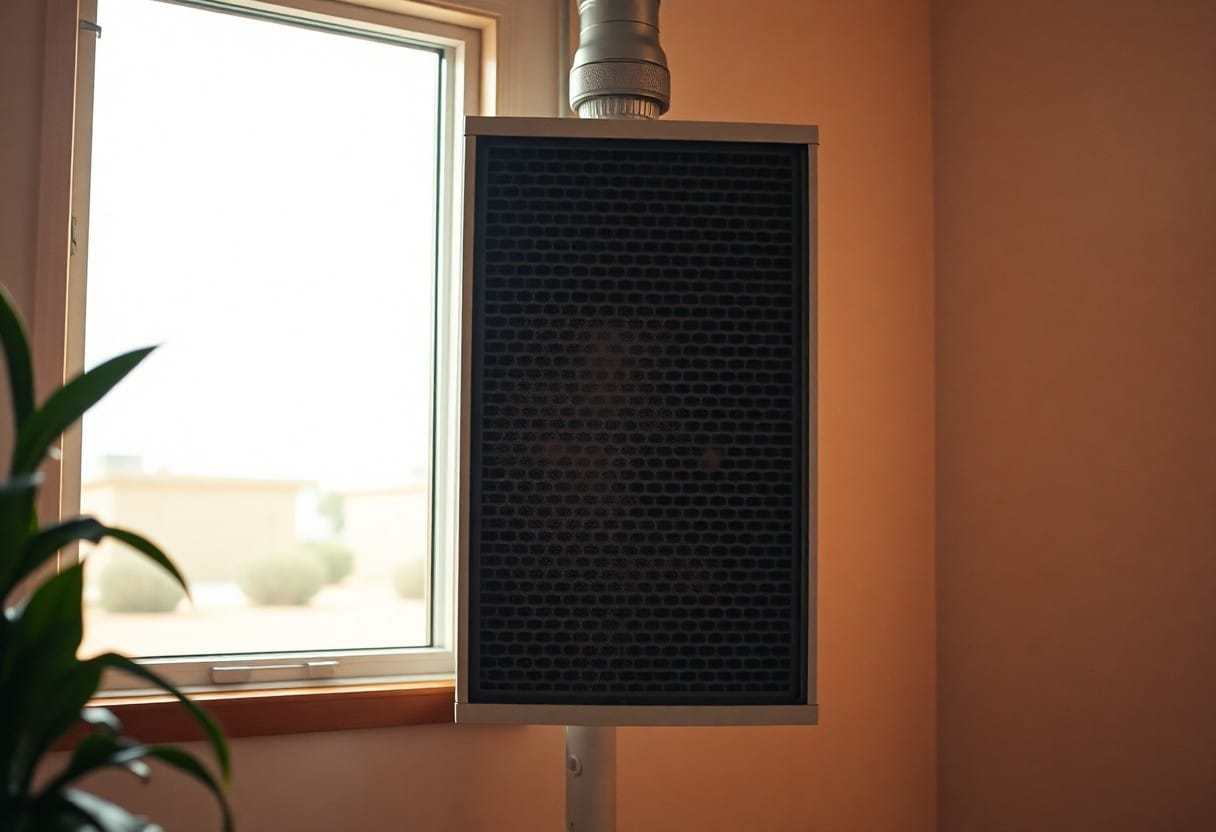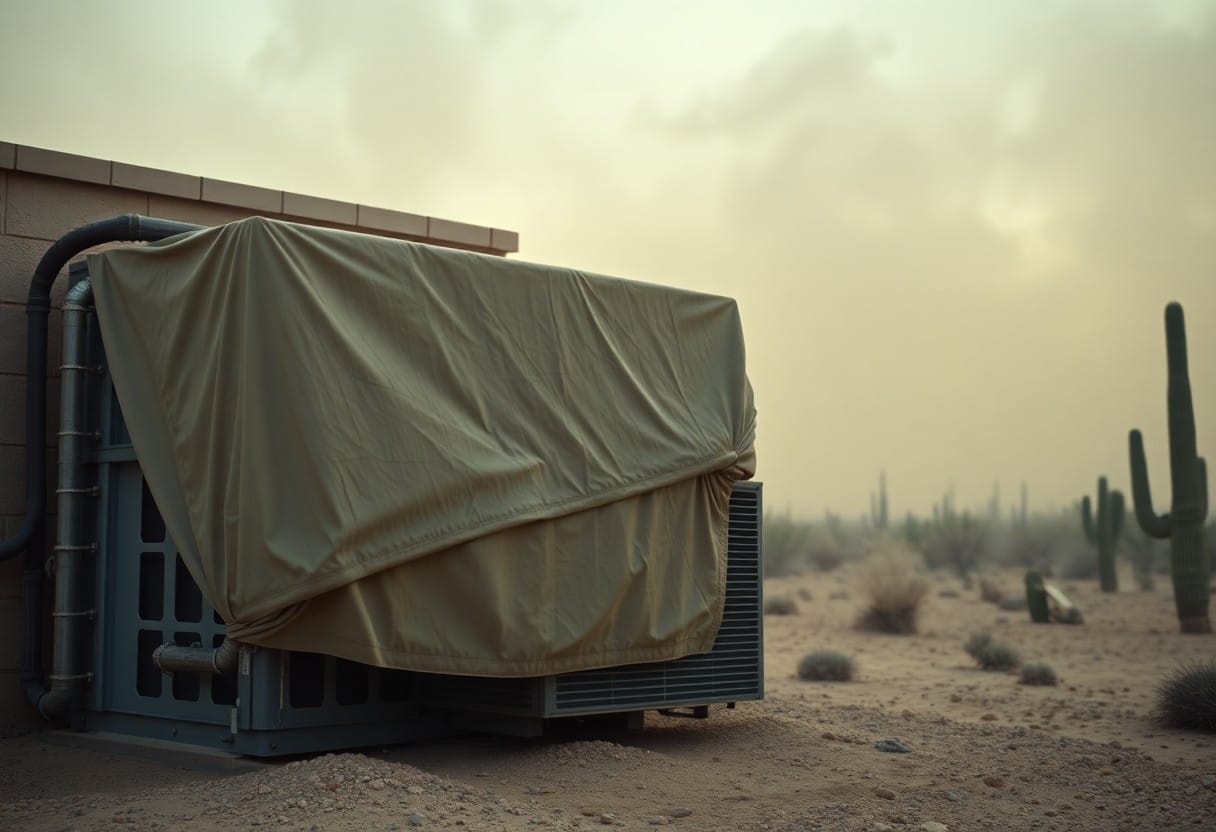Dust storms can significantly impact your HVAC system, leading to costly repairs and decreased efficiency. To protect your investment and ensure optimal performance, it’s imperative to implement effective strategies against the harsh conditions Arizona presents. Regular maintenance, high-quality air filters, and proper sealing can help reduce dust infiltration and extend the lifespan of your system. By prioritizing these protective measures, you can enjoy a comfortable and clean environment while avoiding the negative effects of dust storms on your HVAC system.
Understanding Arizona Dust Storms
Causes and Characteristics
Dust storms in Arizona typically arise from a combination of high winds and dry conditions, often occurring during the summer months. These storms can be triggered by thunderstorms or weather fronts, which create strong gusts that lift loose, dry soil into the air. The state’s sparse vegetation and arid climate enhance the likelihood of dust storms, making them a common phenomenon. When the wind speeds reach over 25 mph, visibility can drop to near-zero in seconds, creating hazardous driving conditions and compounding the challenges for your HVAC system.
On average, Arizona experiences about 50 dust storms annually, with peak occurrences noted during late afternoon and early evening. These storms can range from minor dust clouds to massive walls of dust, known as “haboobs”, that can stretch for miles. Understanding these characteristics helps you anticipate the potential impact on your property, crucial in maintaining the longevity and efficiency of your HVAC system.
Impact on HVAC Systems
After a dust storm, your HVAC system is often inundated with airborne particles that can infiltrate filters and ducts. Dust accumulation can lead to reduced airflow, affecting your system’s efficiency and increasing energy costs. Over time, these particles can also cause wear and tear on components, leading to faster deterioration and the potential for expensive repairs.
Additionally, the presence of dust can exacerbate indoor air quality issues, particularly for those with respiratory conditions. A clogged filter not only hampers your HVAC’s efficiency but also allows allergens and pollutants to circulate. Regular inspection and maintenance become necessary after dust storms to ensure your system’s reliability and your home’s comfort.

Importance of HVAC Protection
Short-term Benefits
The immediate advantages of protecting your HVAC system during Arizona dust storms cannot be overstated. Blocked filters due to dust accumulation can lead to reduced airflow, impacting your system’s efficiency and comfort levels in your home. When you implement protective measures, such as regularly cleaning or replacing filters, you ensure that your HVAC continues to operate at its peak performance. This simple maintenance can save you up to 15% on energy bills in the short term.
Additionally, safeguarding your HVAC system prevents minor issues from escalating into costly repairs. For instance, dust entering sensitive components can lead to premature wear and tear. A well-maintained system enhances your indoor air quality, crucial for those with allergies or respiratory issues. Preventative measures reduce the risk of breakdowns during extreme weather, allowing you to enjoy peace of mind.
Long-term Benefits
Investing in HVAC protection transcends immediate scenarios, offering significant long-term advantages. A protected system can extend its lifespan by several years, minimizing the frequency of costly replacements. Systems that are cleaned and maintained regularly can operate effectively for nearly 15 to 20 years, compared to only a decade for neglected units.
Furthermore, the overall health of your HVAC system affects your property’s market value. Prospective buyers often look for well-maintained systems, which can give you an edge in the real estate market. Energy efficiency ratings also remain high with a properly cared-for unit, resulting in lower monthly bills and increased savings over time. With the right protective strategies, your HVAC setup can be a relatively low-maintenance and efficient system that enhances your home’s livability and comfort.
Long-term protection not only secures your system against mechanical failures but also fosters a sustainable energy environment. As your HVAC functions optimally, its energy consumption decreases significantly, leading to reduced emissions and a smaller carbon footprint. By investing in protective habits now, you create a more reliable system that will pay dividends in performance, comfort, and environmental responsibility over the years to come.
Protective Measures for HVAC Systems
Filtration and Air Quality
Upgrading your HVAC system’s filtration is one of the most effective measures you can take to combat dust storms in Arizona. High-efficiency filters, such as HEPA filters, capture up to 99.97% of airborne particles, including dust, pollen, and other allergens. Regular replacement of these filters, typically every three months, helps maintain optimal air quality and prevents your system from overworking. This is imperative not only for your comfort but also for the health of your family, as cleaner air can significantly reduce respiratory issues.
The placement of your HVAC unit also impacts air quality. Ensure that outdoor units are shielded from direct dust exposure. Creating barriers or installing a protective cover can significantly reduce the amount of dust entering your system during a storm.
Sealing and Insulation
Effective sealing and insulation play a vital role in maintaining the efficiency of your HVAC system. Insulating ductwork can minimize the infiltration of dust and reduce energy loss, leading to lower utility bills. Achieving a tight seal around your windows, doors, and conduit access points can greatly enhance your system’s resilience against airborne particulates during dust storms. Utilizing weatherstripping and caulk will prevent outside air from degrading indoor air quality.
Conducting an energy audit can identify weak points in your home that require sealing. Often, the cost of sealing and insulation is offset by savings in energy costs over time. For instance, a well-sealed home can reduce cooling costs by as much as 20%, illustrating why attention to detail in these areas is beneficial for both comfort and pocketbook.
Understanding the specific areas that allow dust infiltration is key to enhancing your HVAC system’s performance. Focus on the attic, basement, and crawl spaces, as these locations are often overlooked yet can be significant sources of dust contamination. Installing proper ventilation in these areas while ensuring any openings are sealed can further protect your HVAC system from the adverse effects of Arizona’s dust storms.
Maintenance Strategies
Regular Inspections
Scheduling routine inspections of your HVAC system is important to maintaining its efficiency, especially in Arizona’s dusty environment. Technicians can identify issues such as clogged filters, worn-out seals, and potential mechanical failures before they escalate. Ideally, you should conduct these inspections at least twice a year, focusing on pre- and post-season checks to address specific challenges posed by dust storms.
During each inspection, an HVAC professional assesses not only the internal components but also the external housing of your system. They can check for any accumulation of dirt or debris, which can hinder airflow and negatively impact performance. Investing in these inspections can significantly extend the lifespan of your equipment and reduce long-term repair costs.
Cleaning and Replacing Components
Cleaning your HVAC system’s components, such as filters, coils, and ducts, is vital for optimal operation. Dust accumulation can drastically affect airflow and reduce system efficiency. Ensure you clean or replace your air filters every 1-3 months, depending on usage and dust levels. Coils should be cleaned at least once a year to maintain heat exchange efficiency and prevent premature system failure.
Additionally, consider having your ductwork professionally cleaned every few years. This process removes built-up dust and allergens that can circulate through your home, improving air quality and system performance. Regular upkeep of these components not only enhances efficiency but also contributes to a healthier indoor environment.
Upgrading HVAC Systems
Modern Technologies
Integrating modern technologies into your HVAC system can significantly enhance performance and efficiency. Systems equipped with smart thermostats allow for precise temperature control based on your schedule and preferences, reducing energy consumption. Features such as variable speed motors and enhanced SEER (Seasonal Energy Efficiency Ratio) ratings can result in lower utility bills and a more comfortable indoor environment. Consider options that include zoning systems, which allow different areas of your home to be heated or cooled independently, maximizing comfort while minimizing energy use.
Additionally, advancements in air quality technology, like UV air purifiers and advanced filtration systems, can combat the dust and allergens that Arizona’s weather often brings. By utilizing these technologies, you can protect your HVAC system from excessive wear-and-tear, ensuring longevity and reliability. Keeping abreast of these options can lead to a more robust system designed to withstand the unique challenges posed by Arizona’s varying climate.
Custom Solutions for Arizona
Custom solutions tailored specifically for Arizona’s climate can provide your HVAC system with the necessary support to perform optimally. For example, utilizing desert-suitable cooling systems, such as evaporative coolers, can be more energy-efficient alternative in dry conditions. Incorporating improved insulation and reflective roof coatings can also help to regulate indoor temperatures and reduce the load on your HVAC system. These strategies enable your system to deal with the relentless heat and dust effectively.
Working with local HVAC professionals ensures you receive solutions that consider your specific environmental conditions. Customization can address factors such as your home’s orientation, landscaping, and existing infrastructure, creating an integrated system that maximizes efficiency and comfort year-round. This approach not only protects your investment but also enhances the overall air quality and energy performance of your home.

Emergency Preparedness
Preparing for severe dust storms involves more than just securing your home; you need a comprehensive plan for your HVAC system. Ensuring your air conditioning unit can withstand the onslaught of dust is vital for maintaining indoor air quality. Regular maintenance checks are imperative, but knowing how to react during a storm can make all the difference.
Responding to Severe Dust Storms
As a dust storm approaches, having a plan in place allows you to act swiftly. First, turn off your HVAC system to prevent dust from invading the interior of your home. Closing all windows and doors tightly helps create a barrier against dust infiltration. Seal any gaps or cracks in your home to minimize airflow, and use wet towels to cover door thresholds.
Once the storm has passed, assess your HVAC system for any signs of damage. Inspect filters for clogs or excessive dust buildup. If your system was running during the storm, it could now be working harder to push air through a dirty filter, leading to further issues.
Quick Fixes and Temporary Solutions
In the aftermath of a dust storm, you might encounter immediate issues with your HVAC system that require quick fixes. Switching out clogged filters can significantly improve efficiency and air quality. If you lack replacement filters, consider rinsing them with water to remove excess dust until a new one can be installed.
Temporary solutions can also include running air purifiers to enhance indoor air quality and attach them to the HVAC ductwork if possible. Utilizing fans strategically can help circulate air more effectively while ensuring that dust doesn’t settle in your home. Additionally, keeping windows closed during and after a storm prevents outdoor air contamination until the storm’s effects have diminished.
Summing up
Presently, ensuring the protection of your HVAC system from Arizona’s dust storms is crucial for maintaining its efficiency and longevity. By implementing measures such as regular maintenance, using high-quality air filters, and investing in protective covers, you can significantly reduce the impact of dust accumulation on your system. These proactive steps will not only safeguard your HVAC unit but also improve indoor air quality and energy efficiency throughout the year.
Furthermore, staying informed about weather patterns and preparing your home ahead of dust storms can further enhance your HVAC system’s resilience. By taking these preventative actions, you can enjoy a more comfortable and healthier living environment while minimizing repair costs and system failures related to excessive dust exposure. Prioritizing the integrity of your HVAC system enables you to fully benefit from its capabilities, ensuring a reliable climate control solution regardless of the season.

